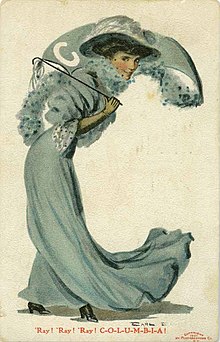
The League of American Bicyclists (LAB), officially the League of American Wheelmen, is a membership organization that promotes cycling for fun, fitness and transportation through advocacy and education. A Section 501(c)(3) nonprofit organization, the League is one of the largest membership organizations of cyclists in the United States.
Free-form, or free-form radio, is a radio station programming format in which the disc jockey is given wide or total control over what music to play, regardless of music genre or commercial interests. Freeform radio stands in contrast to most commercial radio stations, in which DJs have little or no influence over programming structure or playlists. In the United States, freeform DJs are still bound by Federal Communications Commission regulations.
Edison High School may refer to:

The National Register of Historic Places in the United States is a register including buildings, sites, structures, districts, and objects. The Register automatically includes all National Historic Landmarks as well as all historic areas administered by the U.S. National Park Service. Since its introduction in 1966, more than 90,000 separate listings have been added to the register.

In optics, orange has a wavelength between approximately 585 and 620 nm and a hue of 30° in HSV color space. In the RGB color space it is a secondary color numerically halfway between gamma-compressed red and yellow, as can be seen in the RGB color wheel. The complementary color of orange is azure. Orange pigments are largely in the ochre or cadmium families, and absorb mostly blue light.
This is an incomplete list of historic properties and districts at United States colleges and universities that are listed on the National Register of Historic Places (NRHP). This includes National Historic Landmarks (NHLs) and other National Register of Historic Places listings. It includes listings at current and former educational institutions.
The following radio stations broadcast on FM frequency 91.3 MHz:
The following radio stations broadcast on FM frequency 94.3 MHz:
The Association of Public and Land-grant Universities (APLU) is a research, policy, and advocacy organization of public research universities, land-grant institutions, state university systems, and higher education organizations. It has member campuses in all of the United States as well as the District of Columbia, four U.S. territories, Canada, and Mexico.
Many American sports team names and mascots are based upon or use religious symbolism. The majority are scholastic teams at institutions founded by various denominations of Christianity, both Catholic and Protestant. Saints is the most popular of these names not only at religious schools but public schools. However, the latter are often indirect, the schools being located in places named for saints. The only team name that has become controversial is Crusaders, many having changed in recent years. The term, once associated with protectors of the faith is now also associated with oppression. Many Christian schools use "Knights" as their team names with imagery similar to crusaders, but it is difficult to establish religious symbolism in these cases. There are also a number of teams whose name includes demons or devils, which are mythological creatures from many cultures. However, the devil imagery in sports used by professional sports teams as well as public and non-sectarian schools are an example of the Devil in the arts and popular culture more than religion. There are also a few team identities based upon Norse mythology in popular culture.

Varieties of the color blue may differ in hue, chroma, or lightness, or in two or three of these qualities. Variations in value are also called tints and shades, a tint being a blue or other hue mixed with white, a shade being mixed with black. A large selection of these colors is shown below.
Mayors National Climate Action Agenda, or Climate Mayors, is an association of United States mayors with the stated goal of reducing greenhouse gas emissions. Founded by Los Angeles mayor Eric Garcetti, former Houston mayor Annise Parker, and former Philadelphia mayor Michael Nutter, the group represents 435 cities and nearly 20% of the U.S. population.




